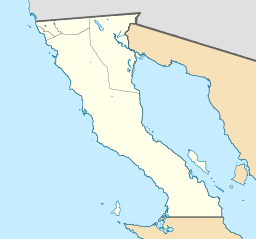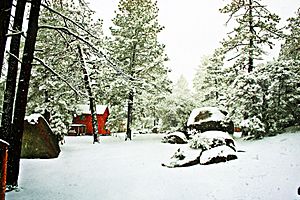Sierra de Juárez facts for kids
Quick facts for kids Sierra de Juárez |
|
|---|---|

Laguna Hanson, in Constitution 1857 National Park
|
|
| Geography | |
| Range coordinates | 31°18′12″N 115°19′30″W / 31.3034°N 115.325°W |
The Sierra de Juárez is a mountain range in northern Baja California, Mexico. It's found in the Tecate Municipality and the northern part of Ensenada Municipality.
This mountain range is a big part of the Peninsular Ranges System. This system stretches from Southern California all the way down the Baja California peninsula into Baja California Sur.
Contents
Exploring the Sierra de Juárez Mountains
The Sierra de Juárez starts just south of the border with California. It stretches about 140 kilometers (87 miles) south. The highest point in the range is about 1,980 meters (6,496 feet) tall. To the north, you'll find the Laguna Mountains in the U.S. To the south, there's the Sierra de San Pedro Mártir in Mexico.
Size and Shape of the Mountains
The Sierra de Juárez covers about 4,568 square kilometers (1,764 square miles). It's about 140 kilometers (87 miles) long and around 33 kilometers (20 miles) wide. On its eastern side, the Sierra de Juárez rises steeply from a desert valley. This valley has the Laguna Salada Fault, which is connected to the famous San Andreas Fault. The western side of the Sierra is much gentler.
Water Flow and Basins
This mountain range is a special spot for water. It's where the southern end of the Great Basin Divide is located. This means water from here can flow in three different directions:
- North into the Great Basin
- West towards the Pacific Ocean
- East into the Gulf of California
Constitution 1857 National Park
A part of the Sierra de Juárez is protected within the Constitution 1857 National Park. This park is about 72 kilometers (45 miles) east of Ensenada. Inside the park, you'll find the beautiful Laguna Hanson. This lake is a very important stop for migratory birds that travel long distances. The park also has special Sierra Juarez and San Pedro Martir pine-oak forests.
Plants and Animals of Sierra de Juárez
The Sierra de Juárez is home to different types of plant life, depending on the elevation.
Lower Elevations: Deserts and Chaparral
The lower parts of the western slopes are covered in coastal sage and chaparral. This is a type of shrubland with tough, woody plants.
The lower parts of the eastern slopes are in the Sonoran Desert. This desert has unique plants that can survive in very dry conditions. One interesting plant here is the California Fan Palm (Washingtonia filifera). This area is close to the southernmost place where these palms naturally grow.
Higher Elevations: Pine-Oak Forests
The higher parts of the Sierra de Juárez, along with the Sierra de San Pedro Mártir, are covered in Sierra Juarez and San Pedro Martir pine-oak forests. These forests have several types of pine trees, including:
- Jeffrey pine (Pinus jeffreyi)
- Parry Piñon pine (Pinus monophylla)
- Lodgepole pine (Pinus contorta)
- Sugar pine (Pinus lambertini)
Other evergreen trees you might see are white fir (Abies concolor) and incense cedar (Calocedrus decurrens). A common shrub growing under these trees is sagebrush (Artemisia tridentata).
These forests in the two mountain ranges are like a "Sky island". This means they are cool, temperate forests surrounded by lower, drier lands.
Climate of the Sierra de Juárez
The western side of the Sierra de Juárez has a Mediterranean climate. This type of climate is common in much of California and northwestern Baja California. It means the area has warm, dry summers and mild, wet winters.
According to CONABIO, a Mexican government agency, the climate in the Sierra de Juárez varies:
- 30% is desert (very dry).
- 7% is steppe (dry grasslands).
- 27% has a mild climate with rain spread throughout the year.
- 36% has a Mediterranean climate, with most rain in winter.
The Laguna Hanson weather station, located at 1,580 meters (5,184 feet) high, has a climate with warm summers and cool winters, and rain throughout the year. However, it's very close to being a Mediterranean climate, with mostly dry summers. Generally, higher elevations in the mountains get more rain than lower areas.
| Climate data for Sierra de Juarez (1951-2010) at Laguna Hanson, elevation: 1,580 metres (5,180 ft) | |||||||||||||
|---|---|---|---|---|---|---|---|---|---|---|---|---|---|
| Month | Jan | Feb | Mar | Apr | May | Jun | Jul | Aug | Sep | Oct | Nov | Dec | Year |
| Record high °C (°F) | 25.5 (77.9) |
26.0 (78.8) |
27.5 (81.5) |
33.0 (91.4) |
33.5 (92.3) |
39.0 (102.2) |
39.5 (103.1) |
40.0 (104.0) |
39.5 (103.1) |
35.0 (95.0) |
31.0 (87.8) |
33.0 (91.4) |
40.0 (104.0) |
| Mean daily maximum °C (°F) | 11.7 (53.1) |
13.1 (55.6) |
12.9 (55.2) |
16.0 (60.8) |
20.3 (68.5) |
24.6 (76.3) |
28.4 (83.1) |
27.9 (82.2) |
25.4 (77.7) |
20.0 (68.0) |
15.7 (60.3) |
13.4 (56.1) |
19.1 (66.4) |
| Daily mean °C (°F) | 4.5 (40.1) |
5.4 (41.7) |
5.7 (42.3) |
8.0 (46.4) |
11.5 (52.7) |
15.1 (59.2) |
19.0 (66.2) |
18.5 (65.3) |
16.2 (61.2) |
11.1 (52.0) |
7.4 (45.3) |
5.4 (41.7) |
10.7 (51.3) |
| Mean daily minimum °C (°F) | −2.7 (27.1) |
−2.3 (27.9) |
−1.6 (29.1) |
0.0 (32.0) |
2.7 (36.9) |
5.6 (42.1) |
9.5 (49.1) |
9.1 (48.4) |
7.1 (44.8) |
2.2 (36.0) |
−0.8 (30.6) |
−2.4 (27.7) |
2.2 (36.0) |
| Record low °C (°F) | −19.0 (−2.2) |
−14.0 (6.8) |
−14.0 (6.8) |
−13.0 (8.6) |
−14.0 (6.8) |
−6.0 (21.2) |
−7.0 (19.4) |
−10.0 (14.0) |
−5.0 (23.0) |
−12.0 (10.4) |
−15.0 (5.0) |
−17.0 (1.4) |
−19.0 (−2.2) |
| Average precipitation mm (inches) | 51.1 (2.01) |
57.0 (2.24) |
68.3 (2.69) |
22.9 (0.90) |
3.9 (0.15) |
0.5 (0.02) |
33.8 (1.33) |
39.9 (1.57) |
21.5 (0.85) |
17.8 (0.70) |
38.1 (1.50) |
36.1 (1.42) |
390.9 (15.39) |
| Average precipitation days (≥ 0.1 mm) | 4.9 | 4.6 | 5.5 | 2.9 | 0.8 | 0.2 | 3.3 | 3.8 | 2.1 | 2.0 | 3.4 | 3.9 | 37.4 |
| Average snowy days | 0.70 | 0.10 | 0.90 | 0.45 | 0 | 0 | 0 | 0 | 0 | 0 | 0.40 | 1.60 | 4.15 |
| Source 1: Servicio Meteorológico Nacional | |||||||||||||
| Source 2: Colegio de Postgraduados | |||||||||||||
See also
 In Spanish: Sierra de Juárez (Baja California) para niños
In Spanish: Sierra de Juárez (Baja California) para niños




